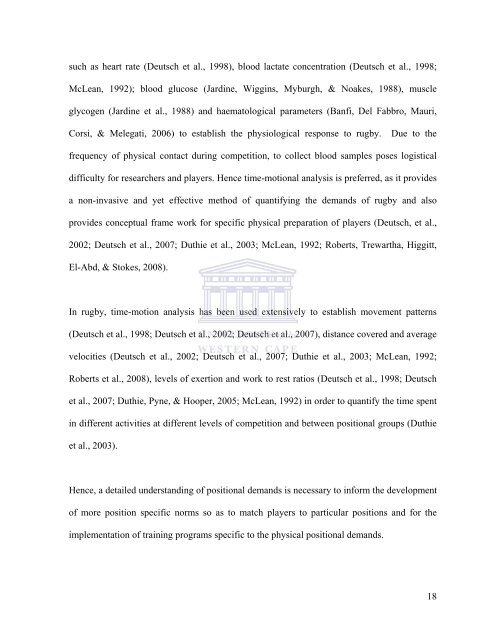Physical fitness of elite women's rugby union players over a ...
Physical fitness of elite women's rugby union players over a ...
Physical fitness of elite women's rugby union players over a ...
Create successful ePaper yourself
Turn your PDF publications into a flip-book with our unique Google optimized e-Paper software.
such as heart rate (Deutsch et al., 1998), blood lactate concentration (Deutsch et al., 1998;<br />
McLean, 1992); blood glucose (Jardine, Wiggins, Myburgh, & Noakes, 1988), muscle<br />
glycogen (Jardine et al., 1988) and haematological parameters (Banfi, Del Fabbro, Mauri,<br />
Corsi, & Melegati, 2006) to establish the physiological response to <strong>rugby</strong>. Due to the<br />
frequency <strong>of</strong> physical contact during competition, to collect blood samples poses logistical<br />
difficulty for researchers and <strong>players</strong>. Hence time-motional analysis is preferred, as it provides<br />
a non-invasive and yet effective method <strong>of</strong> quantifying the demands <strong>of</strong> <strong>rugby</strong> and also<br />
provides conceptual frame work for specific physical preparation <strong>of</strong> <strong>players</strong> (Deutsch, et al.,<br />
2002; Deutsch et al., 2007; Duthie et al., 2003; McLean, 1992; Roberts, Trewartha, Higgitt,<br />
El-Abd, & Stokes, 2008).<br />
In <strong>rugby</strong>, time-motion analysis has been used extensively to establish movement patterns<br />
(Deutsch et al., 1998; Deutsch et al., 2002; Deutsch et al., 2007), distance c<strong>over</strong>ed and average<br />
velocities (Deutsch et al., 2002; Deutsch et al., 2007; Duthie et al., 2003; McLean, 1992;<br />
Roberts et al., 2008), levels <strong>of</strong> exertion and work to rest ratios (Deutsch et al., 1998; Deutsch<br />
et al., 2007; Duthie, Pyne, & Hooper, 2005; McLean, 1992) in order to quantify the time spent<br />
in different activities at different levels <strong>of</strong> competition and between positional groups (Duthie<br />
et al., 2003).<br />
Hence, a detailed understanding <strong>of</strong> positional demands is necessary to inform the development<br />
<strong>of</strong> more position specific norms so as to match <strong>players</strong> to particular positions and for the<br />
implementation <strong>of</strong> training programs specific to the physical positional demands.<br />
18
















